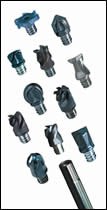Use Only The Carbide Needed
The cost of APT, a key ingredient in tungsten carbide cutting tools, has skyrocketed. In response to this situation and quick-change demands from its customers, Ingersoll Cutting Tools offers a modular line of solid carbide cutting tips that attach to reusable tool shanks.
Increasing efficiency and internal cost control are about the only levers a shop has at its disposal to stay ahead and stay in business. In cutting tools for example, many precision machined parts makers have embraced carbide cutting tools because of their higher speed production capabilities and virtually infinite geometry variations. In the past couple of years though, carbide has come under pressure from increased demand for the material.
Specifically, the cost of APT, a key ingredient in tungsten carbide cutting tools, has skyrocketed. Demand from Asia and other emerging metalcutting markets has pressured available supplies of APT and other raw materials, resulting in higher tooling costs.
In response to this situation and quick-change demands from its customers, Ingersoll Cutting Tools offers a modular line of solid carbide cutting tips that attach to reusable tool shanks. The idea is to help conserve the amount of carbide needed to machine parts by exchanging only the cutting tip of the rotating tool. The company calls the line Chip-Surfer.
This system is engineered for use on today’s modern machining centers and is well suited to Swiss-type machines and turning centers with live-tooling capability. The shank and tool tip are rated at a maximum of 30,000 rpm. They are designed for ballnose, chamfer, spotting, countersinking, corner breaking, drill milling, plunging and T-slotting operations, and they are currently available in end mill sizes between 0.312 and 0.750 inches in diameter.
Standard geometries are pressed and ground. Custom requirements are ground from stocked blanks to expedite delivery. Submicron carbide grades are specified for these tool tips and most are designed using high positive rake angles with a 45-degree helix for free cutting. Based on diameter, end mill tips are stocked with 2, 3, 4, 6, 8 and 10 flute options with various corner configurations.
In operation the shop uses a steel, heavy metal or carbide shank sized for an ER11 or ER16 collet. Because of the free-cutting geometry of the tool tips, new shanks were engineered and stocked with necked-down diameters to allow larger diameter tools in smaller diameter collets without a loss of torque. Shanks are modular and come in various lengths for optimum rigidity in long-reach applications. The shanks are made with steel, heavy metal and carbide materials. Each shank has a female threaded end to accept any of the various cutting tool tips.
Tool tip change-over is quick and repeatable. Once the shank length is set in the ER collet, changing tool tips takes only a few seconds with repeatability of ± 0.0005 inch. With that repeatability, generally no additional tool offset is needed from tip to tip.
The system achieves this accuracy from the tool tip tool shank interface. It uses a simultaneous taper and face fit that provides a rigid connection. A taper in the tool tip fits a mating taper in the tool shank. In addition, a precision flange on the tool tip fits against the face of the tool shank. When the threaded tip is torqued into its seat, these two surfaces mate and provide simultaneous taper and face fit—like an HSK holder.
To change tool tips, the spindle is locked or a wrench is used to prevent shank rotation. The operator then removes only the tool tip using a wrench that fits molded or ground flats in the tip. The replacement tip is then finger tightened into the threaded tool shank leaving a small gap.
Using the wrench, an additional quarter turn of the tip seats it in the shank with taper and face contact. The visible elimination of the “gap” indicates the tool is seated. Right-hand rotation of the tool spindle keeps the connection secure for metalcutting
operations.
If carbide tool prices are impacting your shop and you need to reduce tool change times, this new system from Ingersoll may be worth a look. Its high repeatability, variety of geometries, tool shank modularity and quick-change capability are additional benefits to lowering a user’s carbide usage and more importantly, increasing productivity.
Related Content
The Ins and Outs of Inserts
Understanding how inserts are made provides valuable insight into how their performance can be optimized.
Read MoreRepeatability and Rigidity Are Key for Quick-Change Swiss Tooling
A rotary wedge clamping system is said to enable this two-piece, modular tooling system for Swiss-types to offer the performance of a solid tool.
Read MoreBoring Head Enables Sculpture Hardware to Be Machined on a Lathe
When small job shop Ansonia Manufacturing took on a tricky hardware component job for a “live” glass art sculpture, it realized a boring head would be needed to machine the part complete on its live-tool lathe.
Read MoreTool Path Improves Chip Management for Swiss-Type Lathes
This simple change to a Swiss-type turning machine’s tool path can dramatically improve its ability to manage chips.
Read MoreRead Next
Multifunctional Tool Brings Immediate Savings
What would it be worth to a shop to address a problem job in the morning and by afternoon, be running it 40 percent faster? That was exactly BVR Technologies’ (Rockford, Illinois) situation in regards to a standard carrier—a turned part they were machining on a regular basis.
Read MoreEmerging Leaders Nominations Now Open
Here’s your chance to highlight a young person in your manufacturing business who is on the path to be a future leader moving your company forward.
Read MoreDo You Have Single Points of Failure?
Plans need to be in place before a catastrophic event occurs.
Read More.png;maxWidth=970;quality=90)
















.png;maxWidth=300;quality=90)









